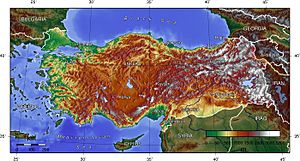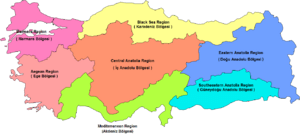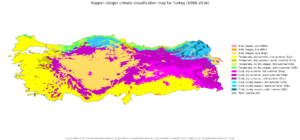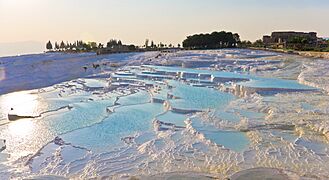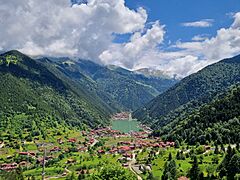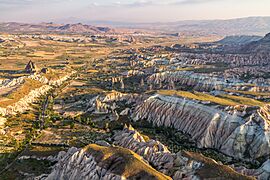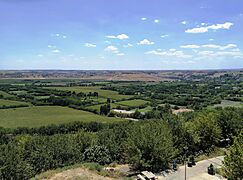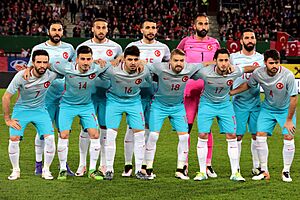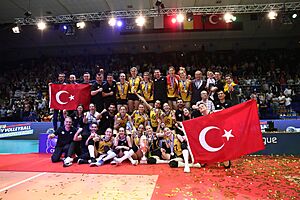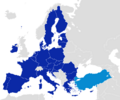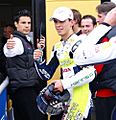Turkey facts for kids
Quick facts for kids
Republic of Türkiye
Türkiye Cumhuriyeti (Turkish)
|
|
|---|---|
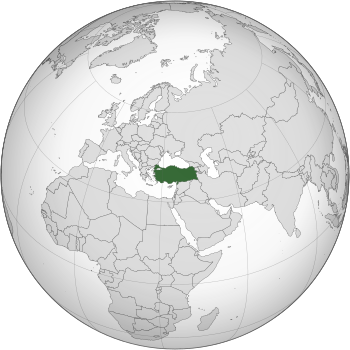 |
|
| Capital | Ankara 39°55′N 32°51′E / 39.917°N 32.850°E |
| Largest city | Istanbul 41°1′N 28°57′E / 41.017°N 28.950°E |
| Official languages | Turkish |
| Spoken languages |
|
| Ethnic groups
(2016)
|
|
| Demonym(s) |
|
| Government | Unitary presidential republic |
| Recep Tayyip Erdoğan | |
| Cevdet Yılmaz | |
| Numan Kurtulmuş | |
| Legislature | Grand National Assembly |
| Establishment | |
| c. 1299 | |
| 19 May 1919 | |
|
• Government of the Grand National Assembly
|
23 April 1920 |
|
• Sultanate abolished
|
1 November 1922 |
| 24 July 1923 | |
|
• Republic declared
|
29 October 1923 |
|
• Current constitution
|
9 November 1982 |
| Area | |
|
• Total
|
783,562 km2 (302,535 sq mi) (36th) |
|
• Water (%)
|
2.03 |
| Population | |
|
• December 2023 estimate
|
|
|
• Density
|
111/km2 (287.5/sq mi) (83rd) |
| GDP (PPP) | 2024 estimate |
|
• Total
|
|
|
• Per capita
|
|
| GDP (nominal) | 2024 estimate |
|
• Total
|
|
|
• Per capita
|
|
| Gini (2019) | medium |
| HDI (2022) | very high · 45th |
| Currency | Turkish lira (₺) (TRY) |
| Time zone | UTC+3 (TRT) |
| Calling code | +90 |
| ISO 3166 code | TR |
| Internet TLD | .tr |
Turkey (Turkish: Türkiye) is a country in both Europe and Asia. The area of Turkey is about 780,000 square kilometres.
Turkey is a republic. There are 81 provinces in Turkey. The money of Turkey is called Turkish Lira. The capital city is Ankara, a city in central Anatolia. The cultural and economic center is Istanbul, which is in Europe. In the past Istanbul was called Constantinople. The republic was founded in 1923, after World War I and a war of independence (Kurtuluş Savaşı). Before that, Turkey was the core of the Ottoman Empire.
Many civilizations were located in the area that is now Turkey, like the Hittites, the Roman Empire and the Byzantine Empire. Many important events in the history of Christianity happened in Turkey. Because it lies in both Europe and Asia, some people see Turkey as the "door" between Europe and Asia.
Modern Turkey's warm and varied climate lets many kinds of food crops grow, and livestock and forestry are important industries. Turkey makes enough food to feed itself. Turkish manufactures include airplanes, electronics, cars, clothing and textiles for home and for other countries.
Turkey is a popular place for tourists to visit. It has hundreds of kilometers of beautiful beaches on its Aegean and Mediterranean coasts, and many important historical places. However, terrorist attacks during the 2010s have reduced its popularity.
Contents
History
People have been living in Anatolia (the Asian part of Turkey - also called Asia Minor) longer than almost anywhere else in the world, except Africa.
The first major empire in the area was the Hittites (during the 18th century to the 13th century BC). The Hittites, who spoke one of the Indo-European languages, developed a high culture in Central Anatolia. Their kingdom was destroyed by the Cimmerians in the 7th century BC and the successor states were Lydia, Caria and Lycia.
From 1950 BCE, Greeks and Assyrians inhabited parts of southeastern Turkey. The Assyrian capital was named Tushhan (900-600 BC). The Assyrians ruled over southeastern Turkey until the Assyrian Empire was conquered by Babylonia in the year 612 BC. Then Anatolia became home for various kingdoms including the Achaemenid Empire, Hellenistic kingdoms, Roman Empire, Byzantine Empire (Eastern Roman Empire), Seljuk Empire, and Mongol Empire.
During the 14th century, after the fall of the Mongol Empire, Lord Osman built a new empire named after himself: the Ottoman Empire. It became one of the longest existing empires of all time. The Empire also stretched across the Balkans, (Yugoslavia and Bulgaria) in Europe. The Kingdom was ruled by Muslim law, but other religions had certain minority rights.
In World War I the Ottoman Empire was one of the Central Powers. During the war, 500,000 Armenians in the Ottoman Empire were massacred in the so-called Armenian Genocide. Turkey denies that the event was genocide. The Central Powers lost the war and the Ottoman Empire was destroyed, but after that Ataturk led the army to get rid of foreign enemies, like the Greeks. Mustafa Kemal Atatürk was the first President of Turkey. He made many changes that made Turkey more modern. But some people did not like some of the things he did because they thought they were against Islam. Religious secondary schools were gotten rid of, for example.
For many years Kurdish guerrillas (usually called the "PKK") led by Abdullah Öcalan have been fighting the Turkish government. They said they were fighting so that the Kurds in the south east of Turkey could have autonomy and decide more things for themselves. But the government and most countries in the world call them terrorists.
Turkey applied for full membership of the EEC in 1987, joined the European Union Customs Union in 1995 and started accession negotiations with the European Union in 2005. Customs Union had an important impact on the Turkish manufacturing sector.
In 2014, prime minister Recep Tayyip Erdoğan won Turkey's first direct presidential election. With a referendum in 2017, the parliamentary republic was replaced by an executive presidential system. The office of the prime minister was abolished, and its powers and duties were transferred to the president.
Administrative divisions
Turkey is subdivided into 81 provinces (il or vilayet) for administrative purposes. Each province is divided into districts (ilçe), for a total of 973 districts. Turkey is also subdivided into 7 regions (bölge) and 21 subregions for geographic, demographic and economic measurements, surveys and classifications.
Government and politics
Turkey is a presidential republic within a multi-party system. The government comprises three branches: first is the legislative branch, which is Grand National Assembly of Turkey; second is the executive branch, which is the President of Turkey; and third is the judicial branch, which includes the Constitutional Court, the Court of Cassation and Court of Jurisdictional Disputes.
The Parliament has 600 seats, distributed among the provinces proportionally to the population. The Parliament and the president serve a five-year terms, with elections on the same day. The president is elected by direct vote and cannot run for re-election after two terms, unless the parliament calls early presidential elections during the second term. The Constitutional Court is composed of 15 members, elected for single 12-year terms. They are obliged to retire when they are over the age of 65.
Geography
Turkey covers an area of 783,562 square kilometres (302,535 square miles). With Turkish straits and Sea of Marmara in between, Turkey bridges Western Asia and Southeastern Europe. Turkey's Asian side covers 97% of its surface, and is often called Anatolia. Another definition of Anatolia's eastern boundary is an imprecise line from the Black Sea to Gulf of Iskenderun. Eastern Thrace, Turkey's European side, includes around 10% of the population and covers 3% of the surface area. The country is encircled by seas on three sides: the Aegean Sea to the west, the Black Sea to the north and the Mediterranean Sea to the south. Turkey is bordered by Georgia, Armenia, Azerbaijan and Iran to the east. To the south, it's bordered by Syria and Iraq. To the north, its Thracian area is bordered by Greece and Bulgaria.
Turkey is divided into "seven major regions": Marmara, Aegean, Central Anatolia, Black Sea, Eastern Anatolia, Southeastern Anatolia and the Mediterranean. As a general trend, the inland Anatolian Plateau becomes increasingly rugged as it progresses eastward. Mountain ranges include Köroğlu and Pontic mountain ranges to the north, and the Taurus Mountains to the south. The Lakes Region contains some of the largest lakes in Turkey such as Lake Beyşehir and Lake Eğirdir.
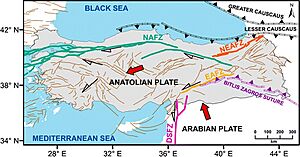
Geographers have used the eastern Anatolian plateau, Iranian plateau, and Armenian plateau terms to refer to the mountainous area around where Arabian and Eurasian tectonic plates merge. The eastern Anatolian plateau and Armenian plateau definitions largely overlap. The Eastern Anatolia Region contains Mount Ararat, Turkey's highest point at 5,137 metres (16,854 feet), and Lake Van, the largest lake in the country. Eastern Turkey is home to the sources of rivers such as the Euphrates, Tigris and Aras. The Southeastern Anatolia Region includes the northern plains of Upper Mesopotamia.
Earthquakes happen frequently in Turkey. Almost the entire population lives in areas with varying seismic risk levels, with around 70% in highest or second-highest seismic areas. Anatolian plate is bordered by North Anatolian Fault zone to the north; East Anatolian Fault zone and Bitlis–Zagros collision zone to the east; Hellenic and Cyprus subduction zones to the south; and Aegean extensional zone to the west. After 1999 İzmit and 1999 Düzce earthquakes, North Anatolian Fault zone activity "is considered to be one of the most dangerous natural hazards in Turkey". 2023 Turkey–Syria earthquakes were the deadliest in contemporary Turkish history. Turkey is sometimes unfavorably compared to Chile, a country with a similar developmental level that is more successful with earthquake preparedness.
Biodiversity

Turkey's position at the crossroads of the land, sea and air routes between the three Old World continents and the variety of the habitats across its geographical regions have produced considerable species diversity and a vibrant ecosystem. Out of the 36 biodiversity hotspots in the world, Turkey includes 3 of them. These are the Mediterranean, Irano-Anatolian, and Caucasus hotspots.
The forests of Turkey are home to the Turkey oak. The most commonly found species of the genus Platanus (plane) is the orientalis. The Turkish pine (Pinus brutia) is mostly found in Turkey and other east Mediterranean countries. Several wild species of tulip are native to Anatolia, and the flower was first introduced to Western Europe with species taken from the Ottoman Empire in the 16th century.
There are 40 national parks, 189 nature parks, 31 nature preserve areas, 80 wildlife protection areas and 109 nature monuments in Turkey such as Gallipoli Peninsula Historical National Park, Mount Nemrut National Park, Ancient Troy National Park, Ölüdeniz Nature Park and Polonezköy Nature Park. The Northern Anatolian conifer and deciduous forests is an ecoregion which covers most of the Pontic Mountains in northern Turkey, while the Caucasus mixed forests extend across the eastern end of the range. The region is home to Eurasian wildlife such as the Eurasian sparrowhawk, golden eagle, eastern imperial eagle, lesser spotted eagle, Caucasian black grouse, red-fronted serin, and wallcreeper.
The Anatolian leopard is still found in very small numbers in the northeastern and southeastern regions of Turkey. The Eurasian lynx, the European wildcat and the caracal are other felid species which are found in the forests of Turkey. The Caspian tiger, now extinct, lived in the easternmost regions of Turkey until the latter half of the 20th century. Renowned domestic animals from Ankara include the Angora cat, Angora rabbit and Angora goat; and from Van Province the Van cat. The national dog breeds are the Kangal (Anatolian Shepherd), Malaklı and Akbaş.
Climate
The coastal areas of Turkey bordering the Aegean and Mediterranean Seas have a temperate Mediterranean climate, with hot, dry summers and mild to cool, wet winters. The coastal areas bordering the Black Sea have a temperate oceanic climate with warm, wet summers and cool to cold, wet winters. The Turkish Black Sea coast receives the most precipitation and is the only region of Turkey that receives high precipitation throughout the year. The eastern part of the Black Sea coast averages 2,200 millimetres (87 in) annually which is the highest precipitation in the country. The coastal areas bordering the Sea of Marmara, which connects the Aegean Sea and the Black Sea, have a transitional climate between a temperate Mediterranean climate and a temperate oceanic climate with warm to hot, moderately dry summers and cool to cold, wet winters.
Snow falls on the coastal areas of the Sea of Marmara and the Black Sea almost every winter but usually melts in no more than a few days. However, snow is rare in the coastal areas of the Aegean Sea and very rare in the coastal areas of the Mediterranean Sea. Winters on the Anatolian plateau are especially severe. Temperatures of −30 to −40 °C (−22 to −40 °F) do occur in northeastern Anatolia, and snow may lie on the ground for at least 120 days of the year, and during the entire year on the summits of the highest mountains. In central Anatolia the temperatures can drop below −20 °C (−4 °F) with the mountains being even colder. Mountains close to the coast prevent Mediterranean influences from extending inland, giving the central Anatolian Plateau a continental climate with sharply contrasting seasons.
Due to socioeconomic, climatic, and geographic factors, Turkey is highly vulnerable to climate change. This applies to nine out of ten climate vulnerability dimensions, such as "average annual risk to wellbeing". OECD median is two out of ten. Inclusive and swift growth is needed for decreasing vulnerability. Turkey aims to achieve net zero emissions by 2053. Accomplishing climate goals would require large investments, but would also result in net economic benefits, broadly due to reduced imports of fuel and due to better health from lowering air pollution.
|
Demographics
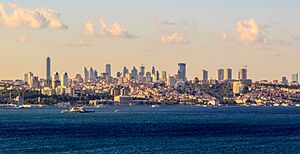
In 2023, the country's population was 85,372,377 in 2023, excluding Syrians under temporary protection. 93% lived in province and district centers. People within the 15–64 and 0–14 age groups corresponded to 68.3% and 21.4% of the total population, respectively. Those aged 65 years or older made up 10.2%. Between 1950 and 2020, Turkey's population more than quadrupled from 20.9 million to 83.6 million; however, the population growth rate was 0.1% in 2023. In 2023, the total fertility rate was 1.51 children per woman, below the replacement rate of 2.10 per woman. In a 2018 health survey, the ideal children number was 2.8 children per woman, rising to 3 per married woman.
Ethnicity and language
There are at least 47 ethnic groups represented in Turkey. According to the World Factbook, 70-75% of the country's citizens are ethnic Turks.
Kurds are the largest ethnic minority. Their exact numbers remain disputed, with estimates ranging from 12 to 20% of the population. According to a 1990 study, Kurds made up around 12% of the population. The Kurds make up a majority in the provinces of Ağrı, Batman, Bingöl, Bitlis, Diyarbakır, Hakkari, Iğdır, Mardin, Muş, Siirt, Şırnak, Tunceli and Van; a near majority in Şanlıurfa (47%); and a large minority in Kars (20%). In addition, internal migration has resulted in Kurdish diaspora communities in all of the major cities in central and western Turkey. In Istanbul, there are an estimated three million Kurds, making it the city with the largest Kurdish population in the world. 19% of adult citizens identified as ethnic Kurds in a survey in 2021. Some people have multiple ethnic identities, such as both Turk and Kurd. In 2006, an estimated 2.7 million ethnic Turks and Kurds were related from interethnic marriages.
According to the World Factbook, non-Kurdish ethnic minorities are 7–12% of the population.
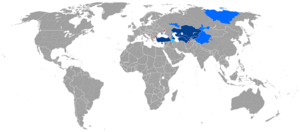
The official language is Turkish, which is the most widely spoken Turkic language in the world. It is spoken by 85% to 90% of the population as a first language. Kurdish speakers are the largest linguistic minority. A survey estimated 13% of the population speak Kurdish or Zaza as a first language. Other minority languages include Arabic, Caucasian languages, and Gagauz. The linguistic rights of the officially recognized minorities are de jure recognized and protected for Armenian, Bulgarian, Greek, Hebrew, and Syriac. There are multiple endangered languages in Turkey.
Culture
In the 19th century, Turkish identity was debated in the Ottoman Empire, with three main views: Turkism, Islamism and Westernism. In addition to Europe or Islam, Turkish culture was also influenced by Anatolia's native cultures. After the establishment of the republic, Kemalism emphasized Turkish culture, attempted to make "Islam a matter of personal conviction", and pursued modernization. Currently, Turkey has various local cultures. Things such as music, folk dance, or kebap variety may be used to identify a local area. Turkey also has a national culture, such as "national movie stars, rock bands, fashion trends, and soccer and basketball leagues".
Literature, theatre, and visual arts
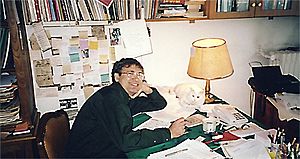

Turkish literature goes back more than a thousand years. The Seljuk and Ottoman periods include numerous works of literature and poetry. Turkic tales and poetry from Central Asia were also kept alive. Tales of Dede Korkut is an example of the oral narrative tradition. Dīwān Lughāt al-Turk, from the 11th century, contains Turkish linguistic information and poetry. Yunus Emre, influenced by Rumi, was one of the most important writers of Anatolian Turkish poetry. Ottoman Divan poetry used "refined diction" and complex vocabulary. It included Sufi mysticism, romanticism, and formal elements.
Beginning in the 19th century, Ottoman literature was influenced by the West. New genres, such as novels and journalistic style, were introduced. Aşk-ı Memnu, written by Halid Ziya Uşaklıgil, was the "first truly refined Turkish novel". Fatma Aliye Topuz, the first female Turkish novelist, wrote fiction. After the proclamation of the republic in 1923, Atatürk instituted reforms such as the language reform and alphabet reform. Since then, Turkish literature reflected the socioeconomic conditions in Turkey with increasing variety. "Village Novel" genre appeared in the mid-1950s, which talked about difficulties faced from poverty. An example is Memed, My Hawk by Yaşar Kemal, which was Turkey's first Nobel Prize in Literature nominee in 1973. Orhan Pamuk won the 2006 Nobel Prize in Literature.
Turkey has four "major theatrical traditions": "folk theatre, popular theatre, court theater, and Western theater." Turkish folk theatre goes back thousands of years and has survived among rural communities. Popular theatre includes plays by live actors, puppet and shadow plays, and storytelling performances. An example for shadow play is Karagöz and Hacivat. Court theatre was the refined version of popular theatre. Beginning in the 19th century, Western theatre tradition started appearing in Turkey. Following the establishment of Turkish Republic, a state conservatory and the State Theatre Company were formed.
Turkey's visual arts scene can be categorized into two, as "decorative" and "fine" arts. Fine arts, or güzel sanatlar, includes sculpture and painting. Turkish artists in these areas have gained global recognition. Photography, fashion design, graphic arts, and graphic design are some of the other areas Turkish artists are known for in the world. The inaugural contemporary Turkish art sale by Sotheby's London was in 2009. Istanbul Modern and the Istanbul Biennial are examples of art galleries or exhibitions of contemporary Turkish art. Turkey has also seen a resurgence of traditional arts. This includes Ottoman-era traditional arts, such as ceramics and carpets. Textile and carpet design, glass and ceramics, calligraphy, paper marbling (ebru) are some of the art forms for which modern-day Turkish artists are recognized as leaders in the Islamic world.
Music and dance

Although classifying genres of Turkish music can be problematic, three broad categories can be considered. These are "Turkish folk music", "Turkish art music", and multiple popular music styles. These Popular music styles include arabesque, pop, and Anatolian rock.
The resurging popularity of pop music gave rise to several international Turkish pop stars such as Ajda Pekkan, Sezen Aksu, Erol Evgin, MFÖ, Tarkan, Sertab Erener, Teoman, Kenan Doğulu, Levent Yüksel and Hande Yener. Internationally acclaimed Turkish jazz and blues musicians and composers include Ahmet Ertegun (founder and president of Atlantic Records), Nükhet Ruacan and Kerem Görsev.
Architecture
Turkey is home to numerous Neolithic settlements, such as Çatalhöyük. From the Bronze Age, important architectural remnants include Alaca Höyük and the 2nd layer of Troy. There are various examples of Ancient Greek and Ancient Roman architectures, especially in the Aegean region. Byzantine architecture dates back to the 4th century AD. Its best example is Hagia Sophia. Byzantine architectural style continued to develop after the conquest of Istanbul, such as Byzantine Revival architecture. During Seljuk Sultanate of Rum and Turkish principalities period, a distinct architecture emerged, which incorporated Byzantine and Armenian architectures with architectural styles found in West Asia and Central Asia. Seljuk architecture often used stones and bricks, and produced numerous caravanserais, madrasas and mausoleums.
Ottoman architecture emerged in northwest Anatolia and Thrace. Early Ottoman architecture mixed "traditional Anatolian Islamic architecture with local building materials and techniques". Following the conquest of Istanbul, classical Ottoman architecture emerged in the 16th and 17th centuries. The most important architect of the classical period is Mimar Sinan, whose major works include the Şehzade Mosque, Süleymaniye Mosque, and Selimiye Mosque. Beginning in the 18th century, Ottoman architecture was influenced by European elements, resulting in development of Ottoman baroque style. European influence continued in the 19th century; examples include works of Balyan family such as neo-Baroque style Dolmabahçe Palace. The last period of Ottoman architecture consists of the First National Architectural Movement, including works of Vedat Tek and Mimar Kemaleddin.
Since 1918, Turkish architecture can be divided into three parts. From 1918 to 1950, the first one includes the First National Architectural Movement period, which transitioned into modernist architecture. Modernist and monumental buildings were preferred for public buildings, whereas "Turkish house" type vernacular architecture influenced private houses. From 1950 to 1980, the second part includes urbanization, modernization, and internationalization. For residential housing, "reinforced concrete, slab-block, medium-rise apartments" became prevalent. Since 1980, the third part is defined by consumer habits and international trends, such as shopping malls and office towers. Luxury residences with "Turkish house style" have been in demand. In the 21st century, urban renewal projects have become a trend. Resilience against natural disasters such as earthquakes is one of the main goals for urban renewal projects. Around one-third of Turkey's building stock, corresponding to 6.7 million units, were assessed risky and needing urban renewal.
Cuisine
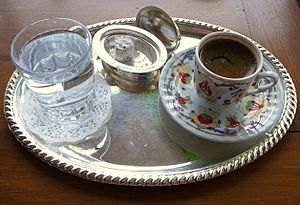
Turkey has a diverse and rich cuisine, varying geographically. Turkish cuisine has been influenced by Anatolian, Mediterranean, Iranian, Central Asian, and East Asian cuisines. Turkish and Ottoman cuisine have also influenced others. Dīwān Lughāt al-Turk, from the 11th century, documents "the ancient lineage of much of present-day Turkish cuisine". Güveç, Bulgur, and Börek are some of the earliest recorded examples of Turkish cuisine. Even though kebab as a word comes from Persian, Turkic people had been familiar with using skewers to cook meat. Turkish cuisine can be distinguished by its various kinds of kebabs. Similarly, pilaf dishes were influenced by Turkish cuisine. Further information about cuisine during the Seljuk and Ottoman periods comes from the works of Rumi and Evliya Çelebi. The latter describes "food-related guilds of Istanbul".
Food staples in Turkey include bread and yogurt. Some of bread varieties are lavash and pide (a type of pita bread). Ayran is a drink made of yoghurt. In western parts of Turkey, olive oil is used. Grains include wheat, maize, barley, oats, and millet. Beans, chickpeas, nuts, aubergines, and lamb are some of the commonly used ingredients. Doner kebab, originally from Turkey, is marinated lamb slices cooked vertically. Seafood includes anchovy and others. Dolma varieties and mantı are made by stuffing vegetables or pasta. Sarma is made by rolling edible leaf over the filling. Yahni dishes are vegetable stews. Turkey is one of the countries with the meze tradition. Honey, pekmez, dried fruit, or fruit are used for sweetening. Filo is an originally Turkish dough that is used to make baklava. Turkish delight is a "delicate but gummy jelly".
Sports
The most popular sport is association football. Galatasaray won the UEFA Cup and UEFA Super Cup in 2000. The Turkey national football team won the bronze medal at the 2002 FIFA World Cup, the 2003 FIFA Confederations Cup and UEFA Euro 2008.
Other mainstream sports such as basketball and volleyball are also popular. The men's national basketball team and women's national basketball team have been successful. Anadolu Efes S.K. is the most successful Turkish basketball club in international competitions. Fenerbahçe reached the final of the EuroLeague in three consecutive seasons (2015–2016, 2016–2017 and 2017–2018), becoming the European champions in 2017.
The final of the 2013–14 EuroLeague Women basketball championship was played between two Turkish teams, Galatasaray and Fenerbahçe, and won by Galatasaray. Fenerbahçe won the 2023 FIBA Europe SuperCup Women after two consecutive Euroleague wins in the 2022–23 and 2023–24 seasons.
The women's national volleyball team has won several medals. Women's volleyball clubs, namely VakıfBank S.K., Fenerbahçe and Eczacıbaşı, have won numerous European championship titles and medals.
The traditional national sport of Turkey has been yağlı güreş (oil wrestling) since Ottoman times. Edirne Province has hosted the annual Kırkpınar oil wrestling tournament since 1361, making it the oldest continuously held sporting competition in the world. In the 19th and early 20th centuries, oil wrestling champions such as Koca Yusuf, Nurullah Hasan and Kızılcıklı Mahmut acquired international fame in Europe and North America by winning world heavyweight wrestling championship titles. International wrestling styles governed by FILA such as freestyle wrestling and Greco-Roman wrestling are also popular, with many European, World and Olympic championship titles won by Turkish wrestlers both individually and as a national team.
Images for kids
-
Some henges at Göbekli Tepe were erected as far back as 9600 BC, predating those of Stonehenge, England by over seven millennia.
-
The Lion Gate in Hattusa, capital of the Hittite Empire. The city's history dates back to the 6th millennium BC.
-
The Library of Celsus in Ephesus was built by the Romans in 114–117 CE. The Temple of Artemis in Ephesus, built by king Croesus of Lydia in the 6th century BC, was one of the Seven Wonders of the Ancient World.
-
Originally a church, later a mosque, and now a museum, the Hagia Sophia in Istanbul was built by the Byzantine emperor Justinian I in 532–537 CE.
-
Mevlana Museum in Konya was built by the Seljuk Turks in 1274. Konya was the capital of the Seljuk Sultanate of Rum (Anatolia).
-
Eighteen female MPs joined the Turkish Parliament with the 1935 general elections. Turkish women gained the right to vote a decade or more before women in such Western European countries as France, Italy, and Belgium — a mark of Atatürk's far-reaching social changes.
-
During the politically unstable periods of the Turkish Republic, the military exercised power directly or through figures like Cemal Gürsel (far right).
-
A view from the Gezi Park protests a view from Taksim, Istanbul on 4th June 2013.
-
Leaders of the G-20 at the 2015 Antalya summit in Turkey.
-
After becoming one of the first members of the Council of Europe in 1949, Turkey became an associate member of the EEC in 1963, joined the EU Customs Union in 1995 and started full membership negotiations with the European Union in 2005.
-
The Turkish Armed Forces collectively rank as the second largest standing military force in NATO, after the US Armed Forces. Turkey joined the alliance in 1952.
-
Sümela Monastery on the Pontic Mountains. These mountains form an ecoregion with diverse temperate rainforest types, flora and fauna.
-
Skyscrapers of Levent business district in Istanbul, Turkey's largest city and leading economic centre.
-
A view of Bankalar Caddesi (Banks Street) in the early years of the Turkish Republic. Completed in 1892, the Ottoman Central Bank headquarters is seen at left. In 1995 the Istanbul Stock Exchange moved to İstinye, while numerous Turkish banks moved their headquarters to the central business districts of Levent and Maslak.
-
Turkish speakers according to the official census of 1965.
-
Sultan Ahmed Mosque in Istanbul is popularly known as the Blue Mosque due to the blue İznik tiles which adorn its interior.
-
Bulgarian St. Stephen Church in Fatih, Istanbul, is famous for being made of prefabricated cast iron elements in the neo-Gothic style.
-
The Grand Synagogue in Edirne.
-
Istanbul University was founded in 1453 as a Darülfünûn. On 1 August 1933 it was reorganised and became Turkey's first university.
-
Imperial College of Medicine, currently the Haydarpaşa campus of Marmara University.
-
Whirling Dervishes of the Sufi Mevlevi Order, founded by the followers of the 13th-century Sufi mystic and poet Rumi in Konya, during a Sema. The ceremony is one of the 11 elements of Turkey on the UNESCO Intangible Cultural Heritage Lists.
-
A 13th century Turkish carpet from the Anatolian Seljuk Sultanate period, originally at the Alâeddin Mosque in Konya.
-
Tevfik Fikret is considered the founder of the modern school of Turkish poetry.
-
TRT World is the international news platform of the Turkish Radio and Television Corporation.
-
Nuri Bilge Ceylan, Turkish film director, photographer and screenwriter who won the 2014 Palme d'Or.
See also
 In Spanish: Turquía para niños
In Spanish: Turquía para niños



